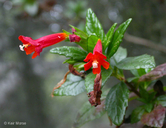Taxon Report
Diplacus parviflorus Greeneisland bush monkeyflower |
 © 2003 Keir Morse |
Taxon Summary
Diplacus parviflorus, commonly known as island bush monkeyflower, is a perennial evergreen shrub in the Phrymaceae that is found only in California. It occurs within Chaparral, Closed-cone coniferous forest, Coastal bluff scrub, and Coastal scrub, growing at elevations from 3 to 535 meters. Diplacus parviflorus is ranked 4.3, Plants of Limited Distribution, A Watch List; Not very threatened in California.Classification
|
Scientific Name: |
Diplacus parviflorus Greene |
|
Common Name: |
island bush monkeyflower |
| Family: | Phrymaceae |
| Element Code: | PDSCR22030 |
| USDA Plants Symbol: | DIPA10 |
|
Synonyms/Other Names: |
|
Ecology and Life History
| Lifeform: | perennial evergreen shrub |
| Blooming Period: Mar-Oct | Mar-Oct |
| Elevation: | 3-535 (10-1755) |
| General Habitats: | Chaparral, Closed-cone coniferous forest, Coastal bluff scrub, Coastal scrub |
| Microhabitat: | Rocky |
| Microhabitat Details: |
Conservation Status
| CA Rare Plant Rank: | 4.3 |
| Global Rank: | G4 |
|
State Rank: |
S4 |
| State List: | None |
| Fed List: | None |
| Other Status: | SB_CalBG/RSABG; SB_CRES |
|
CRPR Changes: |
|
Occurrence Data from the CNDDB
| Total Occurrences: | 0 |
| Element Occurrence Ranks: | |
| Excellent (A) | 0 |
| Good (B) | 0 |
| Fair (C) | 0 |
| Poor (D) | 0 |
| None (X) | 0 |
| Unknown (U) | 0 |
| California Endemic: True | |
| California Counties and Islands: Name (Code) | |
| Los Angeles (LAX), Santa Barbara (SBA), Ventura (VEN) | |
| Quads: Name (Quad Code) | |
| Anacapa Island (3311983), San Clemente Island Central (3211874), San Clemente Island North (3211885), San Clemente Island South (3211873), San Miguel Island East (3312083), Santa Cruz Island A (3311987), Santa Cruz Island B (3311986), Santa Cruz Island C (3311985), Santa Cruz Island D (3311984), Santa Rosa Island East (3311988), Santa Rosa Island North (3312081), Santa Rosa Island South (3312071), Santa Rosa Island West (3312082) | |
Threat List Data from the CNDDB
| Threat List Total: | 0 | |
| EOs with Threat Listed: | Total EOs | % of EOs |
| 0 | 0 % | |
Citation
California Native Plant Society, Rare Plant Program. 2025. Rare Plant Inventory (online edition, v9.5.1). Website https://www.rareplants.cnps.org [accessed 19 December 2025].